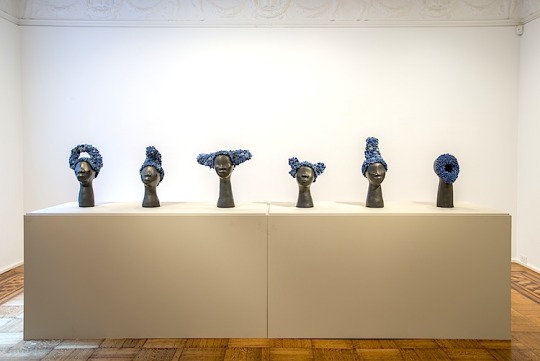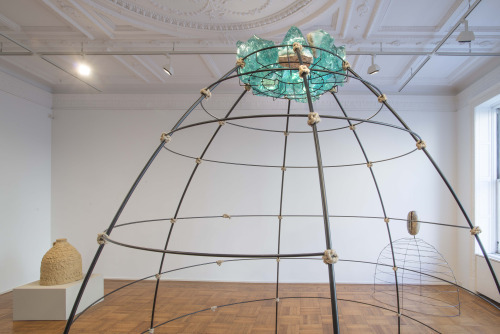
Jane Harris on Sculptor and Installation Artist Simone Leigh
“I’m thinking about embodiment and architecture, dress and dwelling, containment and interiority,” Simone Leigh tells me as we discuss her current exhibition, Moulting, at jTilton Gallery. The stately Upper East Side townhouse seems the perfect space to foreground her ideas, particularly given the issues of race, gender, class,and taste so much of the work engenders.
“Throughout my career I’ve considered the black female body as a repository of lived experience,” she continues, “and this show is part of that ongoing meditation.” While its original title, We the Black Woman, spoke directly to that intent, Leigh’s desire to avoid narrow, essentialist readings led to the more evocative Moulting.
It’s a title that particularly animates the central sculpture in the show, Cupboard III (2015), a 9-foot high dome-like structure, made of steel, and topped with remnants of mason jar glass.
The minimalist work is based on a restaurant in Natchez, Mississippi, called Mammy’s Cupboard, the skirts of which patrons enter into to eat, and is a smaller version of asimilar work created for Gone South, a recent two-person exhibition at
Atlanta’s Contemporary Art Center (2014). As with so much of Leigh’s work, its
abstract, reductive form is imbued with layers of subtext, and a conflation of
references, that conceptually function like a skeuomorph, alluding both to
adaptation and sublimation.
It was through a 1941 black-and-white photograph by the
iconic modernist Edward Weston that Leigh first encountered the restaurant
(opened only the year before, and astonishingly still in existence), an
aesthetic document of American vernacular architecture with no apparent critique.
Holding out a tray above her skirt-cum-restaurant, the Mammy figure entreats
diners to come inside, and in characteristic Mammy servitude appears to welcome
the violation. Beyond the perverse nostalgia associated with a form meant to
signify the inhabitation of a black woman’s body, what struck Leigh most is what
she describes as “the strange sexuality of what was typically an asexual
archetype.”

Simone Leigh, Cupboard III, 2015, Steel, mason jar glass, and hemp rope, Detail view, Courtesy of Tilton Gallery
Perhaps that’s why Leigh’s sculpture lays bare its armature, and sheds the gaily painted ball gown along with all allusions to the novelty architecture: so that, once inside, the viewer becomes its embodiment—at once spectacle and spectator. The destiny to change and adapt implied by the exhibition’s
title is again evoked in the jewel-like cluster of blue tinted mason jar glass
that glints above. Calling our gaze
upward, it’s a classic representation of Leigh’s signature ability to transform
everyday materials—especially containers and vessels—into iconic
abstraction.
In addition to antebellum associations, other sources recalled in the...
You have reached your article limit
Sign up for a digital subscription and continue reading all new issues, plus our entire archives, for just $1.50/month.
Already a subscriber? Sign in




